EHL604: Report on Historical Guest Problems in Hospitality Sector
VerifiedAdded on 2022/12/28
|8
|2216
|46
Report
AI Summary
This individual research report for the EHL604 course examines historical guest problems within the UK hospitality sector, focusing on the challenges of check-in and check-out processes. The report analyzes these problems, exploring the limitations of traditional approaches and the potential of disruptive technologies, specifically cloud computing, to improve efficiency and customer satisfaction. It details the advantages and disadvantages of cloud technology for both guests and the industry, and applies a design thinking approach to customer profiling, specifically targeting Gen Z travelers. The report concludes by summarizing the key findings and emphasizing the importance of adapting to technological advancements to meet evolving customer expectations. It covers topics like entrepreneurship, intrapreneurship, disruptive technologies, and design thinking to provide a comprehensive overview of the hospitality sector and the importance of innovation.
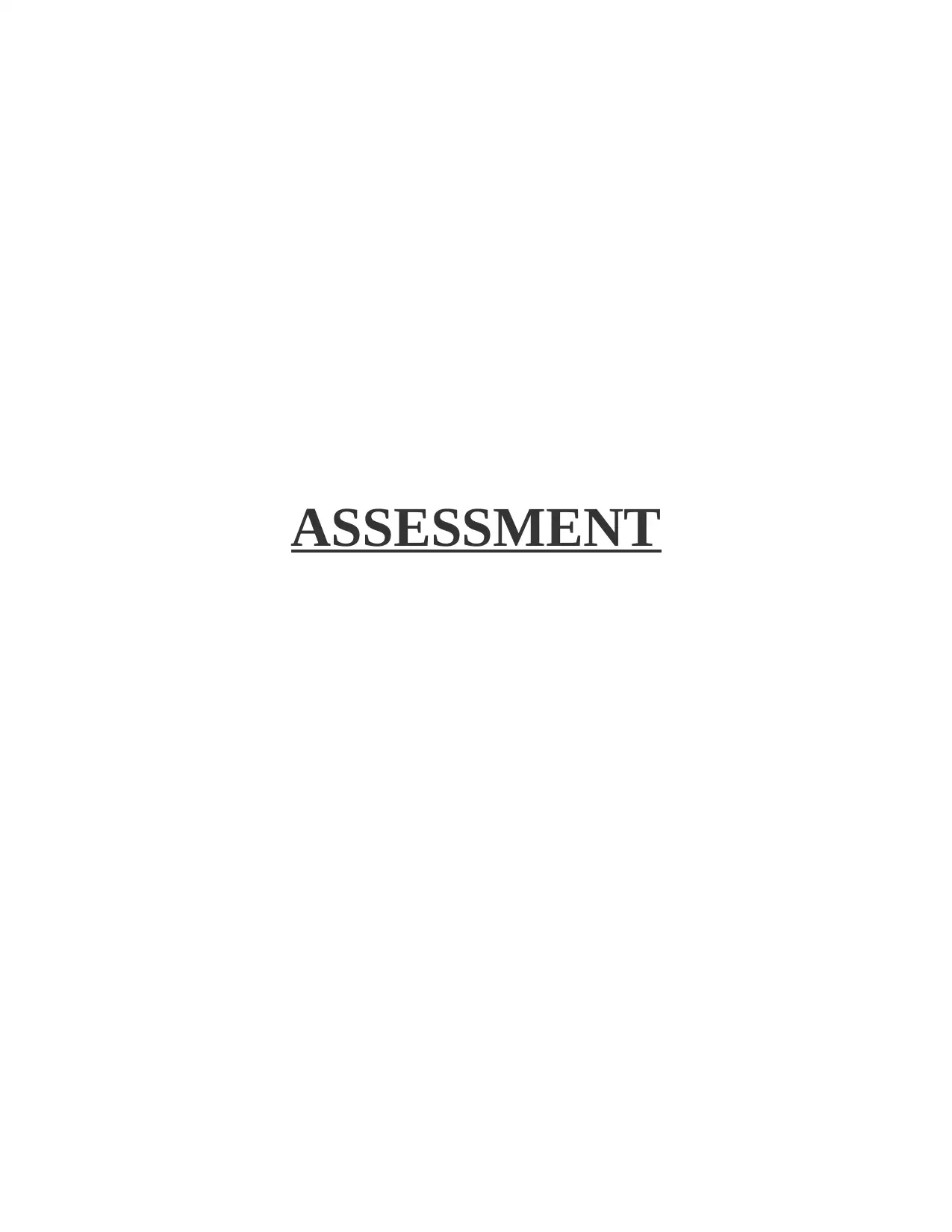
ASSESSMENT
Paraphrase This Document
Need a fresh take? Get an instant paraphrase of this document with our AI Paraphraser
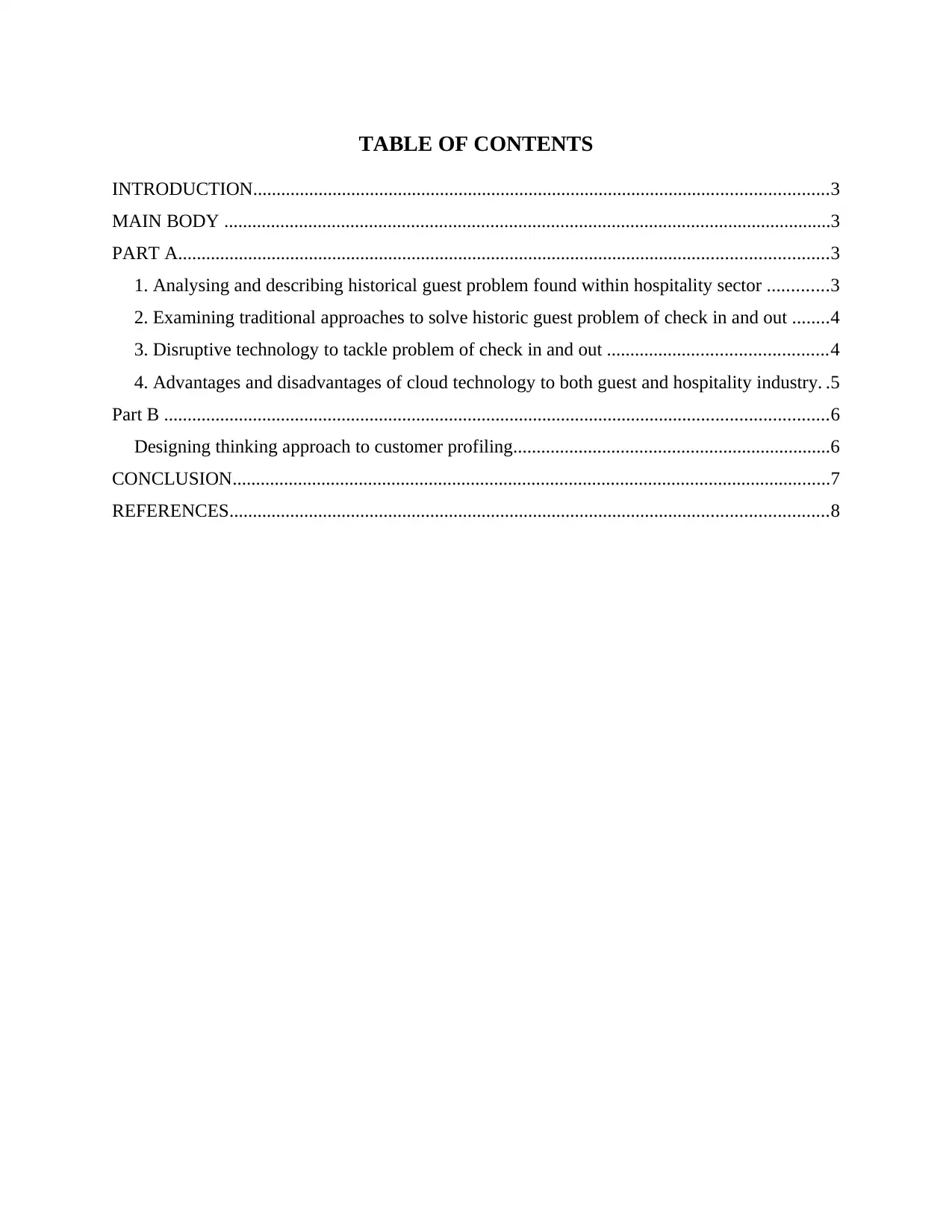
TABLE OF CONTENTS
INTRODUCTION...........................................................................................................................3
MAIN BODY ..................................................................................................................................3
PART A...........................................................................................................................................3
1. Analysing and describing historical guest problem found within hospitality sector .............3
2. Examining traditional approaches to solve historic guest problem of check in and out ........4
3. Disruptive technology to tackle problem of check in and out ...............................................4
4. Advantages and disadvantages of cloud technology to both guest and hospitality industry. .5
Part B ..............................................................................................................................................6
Designing thinking approach to customer profiling....................................................................6
CONCLUSION................................................................................................................................7
REFERENCES................................................................................................................................8
INTRODUCTION...........................................................................................................................3
MAIN BODY ..................................................................................................................................3
PART A...........................................................................................................................................3
1. Analysing and describing historical guest problem found within hospitality sector .............3
2. Examining traditional approaches to solve historic guest problem of check in and out ........4
3. Disruptive technology to tackle problem of check in and out ...............................................4
4. Advantages and disadvantages of cloud technology to both guest and hospitality industry. .5
Part B ..............................................................................................................................................6
Designing thinking approach to customer profiling....................................................................6
CONCLUSION................................................................................................................................7
REFERENCES................................................................................................................................8
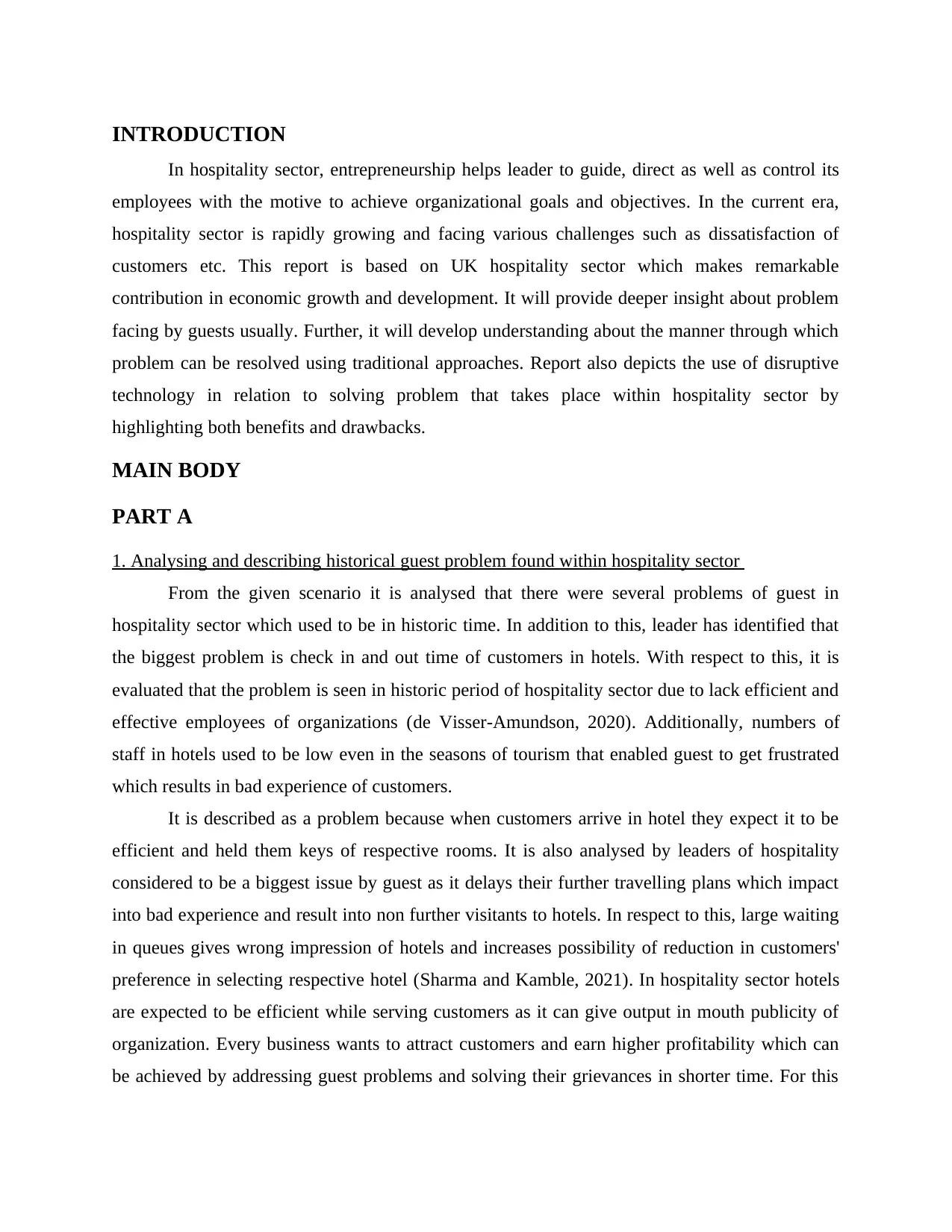
INTRODUCTION
In hospitality sector, entrepreneurship helps leader to guide, direct as well as control its
employees with the motive to achieve organizational goals and objectives. In the current era,
hospitality sector is rapidly growing and facing various challenges such as dissatisfaction of
customers etc. This report is based on UK hospitality sector which makes remarkable
contribution in economic growth and development. It will provide deeper insight about problem
facing by guests usually. Further, it will develop understanding about the manner through which
problem can be resolved using traditional approaches. Report also depicts the use of disruptive
technology in relation to solving problem that takes place within hospitality sector by
highlighting both benefits and drawbacks.
MAIN BODY
PART A
1. Analysing and describing historical guest problem found within hospitality sector
From the given scenario it is analysed that there were several problems of guest in
hospitality sector which used to be in historic time. In addition to this, leader has identified that
the biggest problem is check in and out time of customers in hotels. With respect to this, it is
evaluated that the problem is seen in historic period of hospitality sector due to lack efficient and
effective employees of organizations (de Visser-Amundson, 2020). Additionally, numbers of
staff in hotels used to be low even in the seasons of tourism that enabled guest to get frustrated
which results in bad experience of customers.
It is described as a problem because when customers arrive in hotel they expect it to be
efficient and held them keys of respective rooms. It is also analysed by leaders of hospitality
considered to be a biggest issue by guest as it delays their further travelling plans which impact
into bad experience and result into non further visitants to hotels. In respect to this, large waiting
in queues gives wrong impression of hotels and increases possibility of reduction in customers'
preference in selecting respective hotel (Sharma and Kamble, 2021). In hospitality sector hotels
are expected to be efficient while serving customers as it can give output in mouth publicity of
organization. Every business wants to attract customers and earn higher profitability which can
be achieved by addressing guest problems and solving their grievances in shorter time. For this
In hospitality sector, entrepreneurship helps leader to guide, direct as well as control its
employees with the motive to achieve organizational goals and objectives. In the current era,
hospitality sector is rapidly growing and facing various challenges such as dissatisfaction of
customers etc. This report is based on UK hospitality sector which makes remarkable
contribution in economic growth and development. It will provide deeper insight about problem
facing by guests usually. Further, it will develop understanding about the manner through which
problem can be resolved using traditional approaches. Report also depicts the use of disruptive
technology in relation to solving problem that takes place within hospitality sector by
highlighting both benefits and drawbacks.
MAIN BODY
PART A
1. Analysing and describing historical guest problem found within hospitality sector
From the given scenario it is analysed that there were several problems of guest in
hospitality sector which used to be in historic time. In addition to this, leader has identified that
the biggest problem is check in and out time of customers in hotels. With respect to this, it is
evaluated that the problem is seen in historic period of hospitality sector due to lack efficient and
effective employees of organizations (de Visser-Amundson, 2020). Additionally, numbers of
staff in hotels used to be low even in the seasons of tourism that enabled guest to get frustrated
which results in bad experience of customers.
It is described as a problem because when customers arrive in hotel they expect it to be
efficient and held them keys of respective rooms. It is also analysed by leaders of hospitality
considered to be a biggest issue by guest as it delays their further travelling plans which impact
into bad experience and result into non further visitants to hotels. In respect to this, large waiting
in queues gives wrong impression of hotels and increases possibility of reduction in customers'
preference in selecting respective hotel (Sharma and Kamble, 2021). In hospitality sector hotels
are expected to be efficient while serving customers as it can give output in mouth publicity of
organization. Every business wants to attract customers and earn higher profitability which can
be achieved by addressing guest problems and solving their grievances in shorter time. For this
⊘ This is a preview!⊘
Do you want full access?
Subscribe today to unlock all pages.

Trusted by 1+ million students worldwide
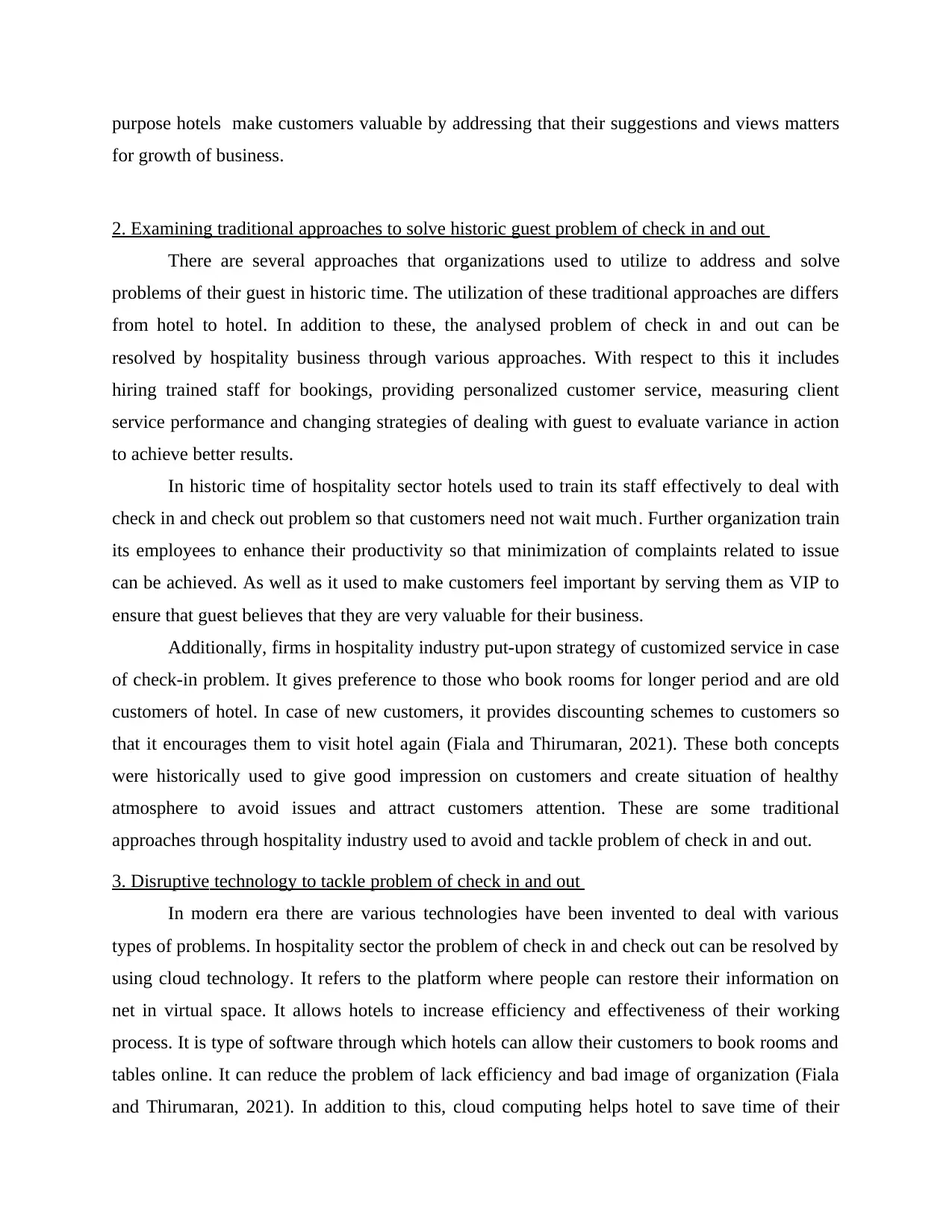
purpose hotels make customers valuable by addressing that their suggestions and views matters
for growth of business.
2. Examining traditional approaches to solve historic guest problem of check in and out
There are several approaches that organizations used to utilize to address and solve
problems of their guest in historic time. The utilization of these traditional approaches are differs
from hotel to hotel. In addition to these, the analysed problem of check in and out can be
resolved by hospitality business through various approaches. With respect to this it includes
hiring trained staff for bookings, providing personalized customer service, measuring client
service performance and changing strategies of dealing with guest to evaluate variance in action
to achieve better results.
In historic time of hospitality sector hotels used to train its staff effectively to deal with
check in and check out problem so that customers need not wait much. Further organization train
its employees to enhance their productivity so that minimization of complaints related to issue
can be achieved. As well as it used to make customers feel important by serving them as VIP to
ensure that guest believes that they are very valuable for their business.
Additionally, firms in hospitality industry put-upon strategy of customized service in case
of check-in problem. It gives preference to those who book rooms for longer period and are old
customers of hotel. In case of new customers, it provides discounting schemes to customers so
that it encourages them to visit hotel again (Fiala and Thirumaran, 2021). These both concepts
were historically used to give good impression on customers and create situation of healthy
atmosphere to avoid issues and attract customers attention. These are some traditional
approaches through hospitality industry used to avoid and tackle problem of check in and out.
3. Disruptive technology to tackle problem of check in and out
In modern era there are various technologies have been invented to deal with various
types of problems. In hospitality sector the problem of check in and check out can be resolved by
using cloud technology. It refers to the platform where people can restore their information on
net in virtual space. It allows hotels to increase efficiency and effectiveness of their working
process. It is type of software through which hotels can allow their customers to book rooms and
tables online. It can reduce the problem of lack efficiency and bad image of organization (Fiala
and Thirumaran, 2021). In addition to this, cloud computing helps hotel to save time of their
for growth of business.
2. Examining traditional approaches to solve historic guest problem of check in and out
There are several approaches that organizations used to utilize to address and solve
problems of their guest in historic time. The utilization of these traditional approaches are differs
from hotel to hotel. In addition to these, the analysed problem of check in and out can be
resolved by hospitality business through various approaches. With respect to this it includes
hiring trained staff for bookings, providing personalized customer service, measuring client
service performance and changing strategies of dealing with guest to evaluate variance in action
to achieve better results.
In historic time of hospitality sector hotels used to train its staff effectively to deal with
check in and check out problem so that customers need not wait much. Further organization train
its employees to enhance their productivity so that minimization of complaints related to issue
can be achieved. As well as it used to make customers feel important by serving them as VIP to
ensure that guest believes that they are very valuable for their business.
Additionally, firms in hospitality industry put-upon strategy of customized service in case
of check-in problem. It gives preference to those who book rooms for longer period and are old
customers of hotel. In case of new customers, it provides discounting schemes to customers so
that it encourages them to visit hotel again (Fiala and Thirumaran, 2021). These both concepts
were historically used to give good impression on customers and create situation of healthy
atmosphere to avoid issues and attract customers attention. These are some traditional
approaches through hospitality industry used to avoid and tackle problem of check in and out.
3. Disruptive technology to tackle problem of check in and out
In modern era there are various technologies have been invented to deal with various
types of problems. In hospitality sector the problem of check in and check out can be resolved by
using cloud technology. It refers to the platform where people can restore their information on
net in virtual space. It allows hotels to increase efficiency and effectiveness of their working
process. It is type of software through which hotels can allow their customers to book rooms and
tables online. It can reduce the problem of lack efficiency and bad image of organization (Fiala
and Thirumaran, 2021). In addition to this, cloud computing helps hotel to save time of their
Paraphrase This Document
Need a fresh take? Get an instant paraphrase of this document with our AI Paraphraser
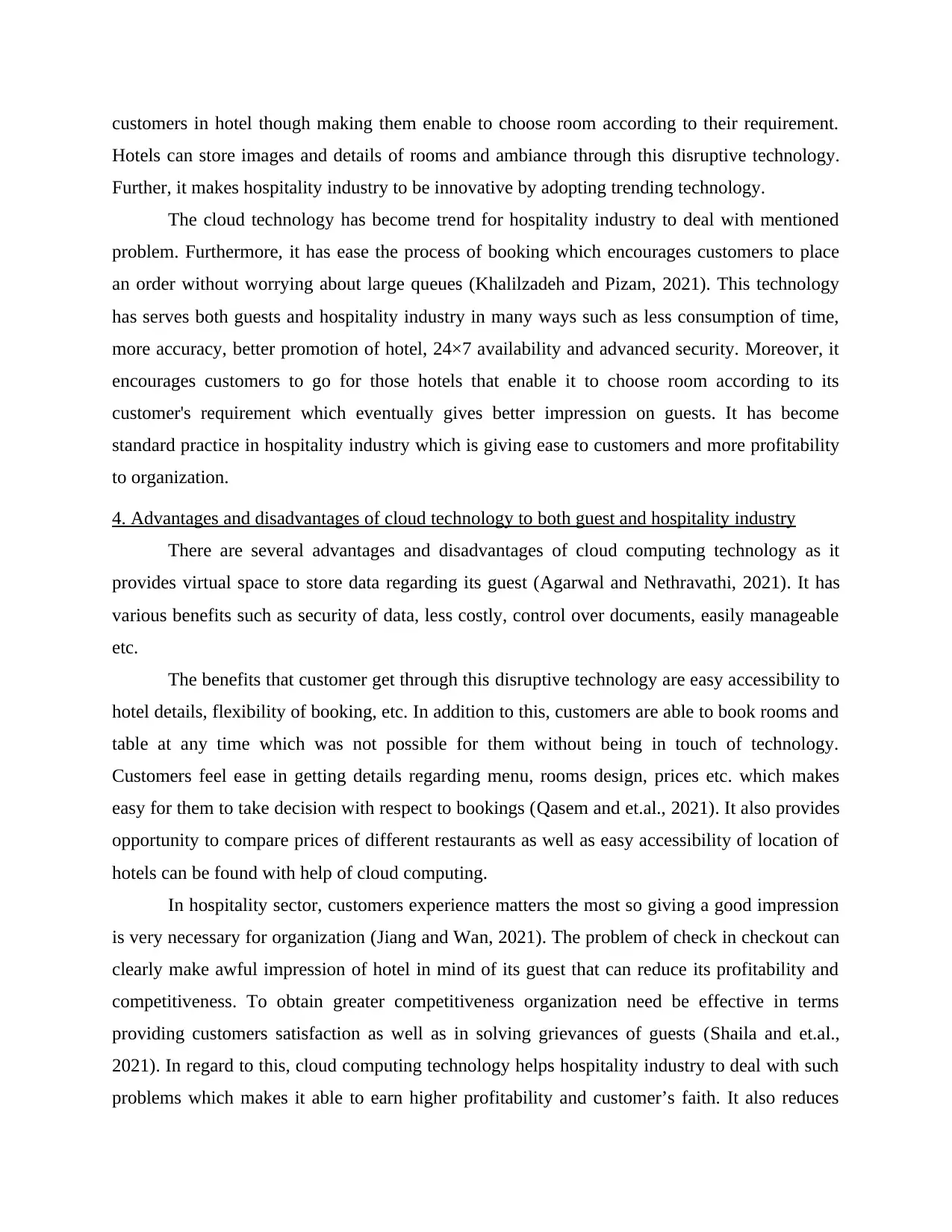
customers in hotel though making them enable to choose room according to their requirement.
Hotels can store images and details of rooms and ambiance through this disruptive technology.
Further, it makes hospitality industry to be innovative by adopting trending technology.
The cloud technology has become trend for hospitality industry to deal with mentioned
problem. Furthermore, it has ease the process of booking which encourages customers to place
an order without worrying about large queues (Khalilzadeh and Pizam, 2021). This technology
has serves both guests and hospitality industry in many ways such as less consumption of time,
more accuracy, better promotion of hotel, 24×7 availability and advanced security. Moreover, it
encourages customers to go for those hotels that enable it to choose room according to its
customer's requirement which eventually gives better impression on guests. It has become
standard practice in hospitality industry which is giving ease to customers and more profitability
to organization.
4. Advantages and disadvantages of cloud technology to both guest and hospitality industry
There are several advantages and disadvantages of cloud computing technology as it
provides virtual space to store data regarding its guest (Agarwal and Nethravathi, 2021). It has
various benefits such as security of data, less costly, control over documents, easily manageable
etc.
The benefits that customer get through this disruptive technology are easy accessibility to
hotel details, flexibility of booking, etc. In addition to this, customers are able to book rooms and
table at any time which was not possible for them without being in touch of technology.
Customers feel ease in getting details regarding menu, rooms design, prices etc. which makes
easy for them to take decision with respect to bookings (Qasem and et.al., 2021). It also provides
opportunity to compare prices of different restaurants as well as easy accessibility of location of
hotels can be found with help of cloud computing.
In hospitality sector, customers experience matters the most so giving a good impression
is very necessary for organization (Jiang and Wan, 2021). The problem of check in checkout can
clearly make awful impression of hotel in mind of its guest that can reduce its profitability and
competitiveness. To obtain greater competitiveness organization need be effective in terms
providing customers satisfaction as well as in solving grievances of guests (Shaila and et.al.,
2021). In regard to this, cloud computing technology helps hospitality industry to deal with such
problems which makes it able to earn higher profitability and customer’s faith. It also reduces
Hotels can store images and details of rooms and ambiance through this disruptive technology.
Further, it makes hospitality industry to be innovative by adopting trending technology.
The cloud technology has become trend for hospitality industry to deal with mentioned
problem. Furthermore, it has ease the process of booking which encourages customers to place
an order without worrying about large queues (Khalilzadeh and Pizam, 2021). This technology
has serves both guests and hospitality industry in many ways such as less consumption of time,
more accuracy, better promotion of hotel, 24×7 availability and advanced security. Moreover, it
encourages customers to go for those hotels that enable it to choose room according to its
customer's requirement which eventually gives better impression on guests. It has become
standard practice in hospitality industry which is giving ease to customers and more profitability
to organization.
4. Advantages and disadvantages of cloud technology to both guest and hospitality industry
There are several advantages and disadvantages of cloud computing technology as it
provides virtual space to store data regarding its guest (Agarwal and Nethravathi, 2021). It has
various benefits such as security of data, less costly, control over documents, easily manageable
etc.
The benefits that customer get through this disruptive technology are easy accessibility to
hotel details, flexibility of booking, etc. In addition to this, customers are able to book rooms and
table at any time which was not possible for them without being in touch of technology.
Customers feel ease in getting details regarding menu, rooms design, prices etc. which makes
easy for them to take decision with respect to bookings (Qasem and et.al., 2021). It also provides
opportunity to compare prices of different restaurants as well as easy accessibility of location of
hotels can be found with help of cloud computing.
In hospitality sector, customers experience matters the most so giving a good impression
is very necessary for organization (Jiang and Wan, 2021). The problem of check in checkout can
clearly make awful impression of hotel in mind of its guest that can reduce its profitability and
competitiveness. To obtain greater competitiveness organization need be effective in terms
providing customers satisfaction as well as in solving grievances of guests (Shaila and et.al.,
2021). In regard to this, cloud computing technology helps hospitality industry to deal with such
problems which makes it able to earn higher profitability and customer’s faith. It also reduces
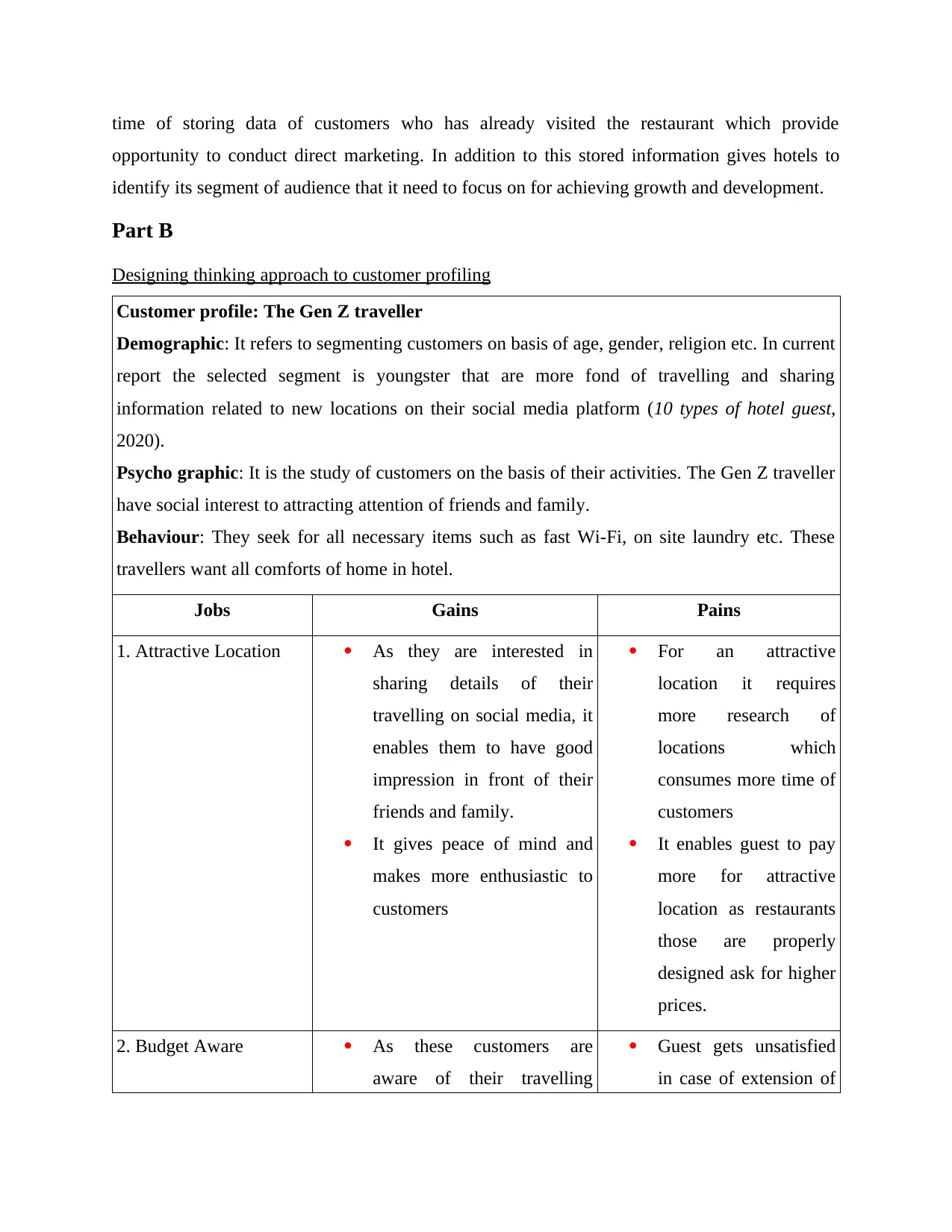
time of storing data of customers who has already visited the restaurant which provide
opportunity to conduct direct marketing. In addition to this stored information gives hotels to
identify its segment of audience that it need to focus on for achieving growth and development.
Part B
Designing thinking approach to customer profiling
Customer profile: The Gen Z traveller
Demographic: It refers to segmenting customers on basis of age, gender, religion etc. In current
report the selected segment is youngster that are more fond of travelling and sharing
information related to new locations on their social media platform (10 types of hotel guest,
2020).
Psycho graphic: It is the study of customers on the basis of their activities. The Gen Z traveller
have social interest to attracting attention of friends and family.
Behaviour: They seek for all necessary items such as fast Wi-Fi, on site laundry etc. These
travellers want all comforts of home in hotel.
Jobs Gains Pains
1. Attractive Location As they are interested in
sharing details of their
travelling on social media, it
enables them to have good
impression in front of their
friends and family.
It gives peace of mind and
makes more enthusiastic to
customers
For an attractive
location it requires
more research of
locations which
consumes more time of
customers
It enables guest to pay
more for attractive
location as restaurants
those are properly
designed ask for higher
prices.
2. Budget Aware As these customers are
aware of their travelling
Guest gets unsatisfied
in case of extension of
opportunity to conduct direct marketing. In addition to this stored information gives hotels to
identify its segment of audience that it need to focus on for achieving growth and development.
Part B
Designing thinking approach to customer profiling
Customer profile: The Gen Z traveller
Demographic: It refers to segmenting customers on basis of age, gender, religion etc. In current
report the selected segment is youngster that are more fond of travelling and sharing
information related to new locations on their social media platform (10 types of hotel guest,
2020).
Psycho graphic: It is the study of customers on the basis of their activities. The Gen Z traveller
have social interest to attracting attention of friends and family.
Behaviour: They seek for all necessary items such as fast Wi-Fi, on site laundry etc. These
travellers want all comforts of home in hotel.
Jobs Gains Pains
1. Attractive Location As they are interested in
sharing details of their
travelling on social media, it
enables them to have good
impression in front of their
friends and family.
It gives peace of mind and
makes more enthusiastic to
customers
For an attractive
location it requires
more research of
locations which
consumes more time of
customers
It enables guest to pay
more for attractive
location as restaurants
those are properly
designed ask for higher
prices.
2. Budget Aware As these customers are
aware of their travelling
Guest gets unsatisfied
in case of extension of
⊘ This is a preview!⊘
Do you want full access?
Subscribe today to unlock all pages.

Trusted by 1+ million students worldwide
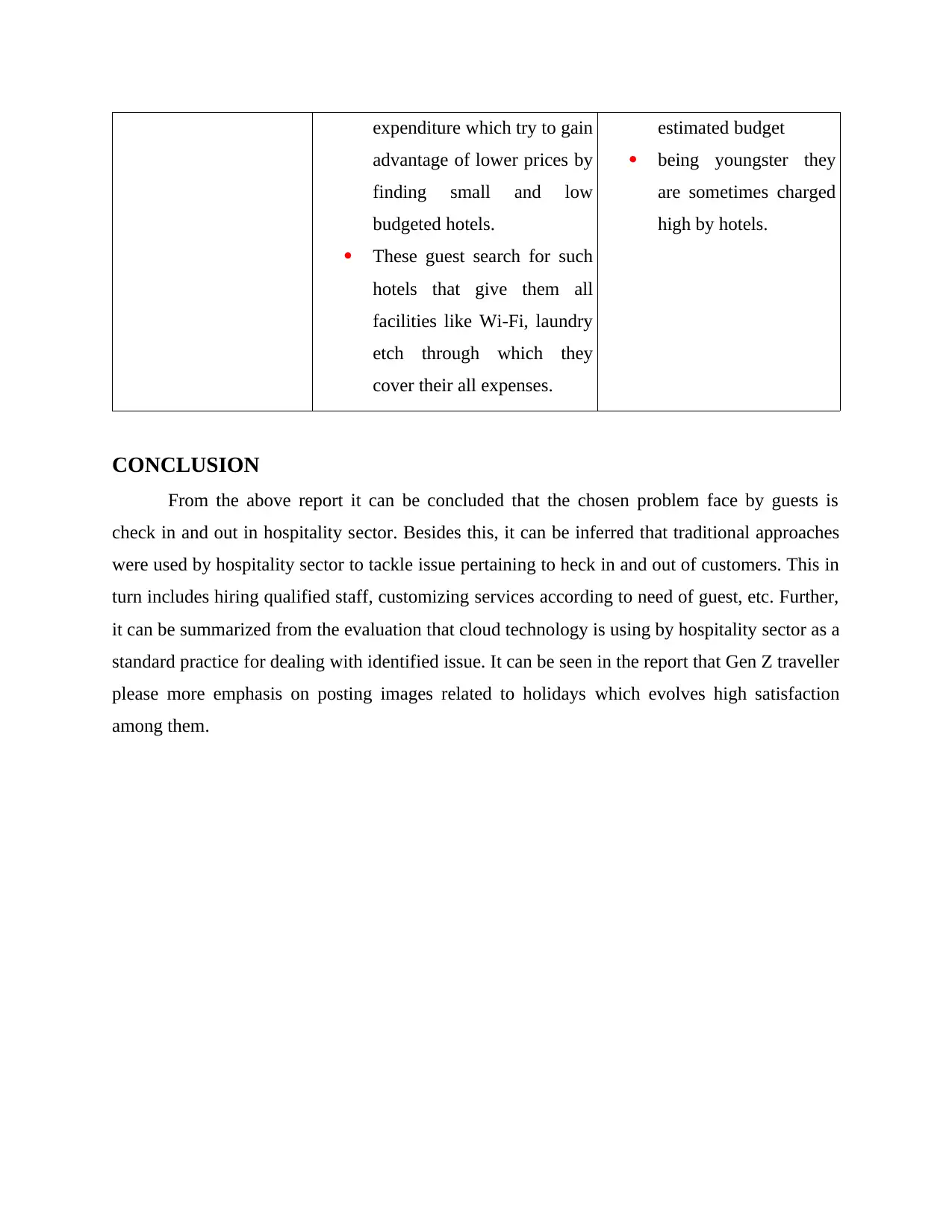
expenditure which try to gain
advantage of lower prices by
finding small and low
budgeted hotels.
These guest search for such
hotels that give them all
facilities like Wi-Fi, laundry
etch through which they
cover their all expenses.
estimated budget
being youngster they
are sometimes charged
high by hotels.
CONCLUSION
From the above report it can be concluded that the chosen problem face by guests is
check in and out in hospitality sector. Besides this, it can be inferred that traditional approaches
were used by hospitality sector to tackle issue pertaining to heck in and out of customers. This in
turn includes hiring qualified staff, customizing services according to need of guest, etc. Further,
it can be summarized from the evaluation that cloud technology is using by hospitality sector as a
standard practice for dealing with identified issue. It can be seen in the report that Gen Z traveller
please more emphasis on posting images related to holidays which evolves high satisfaction
among them.
advantage of lower prices by
finding small and low
budgeted hotels.
These guest search for such
hotels that give them all
facilities like Wi-Fi, laundry
etch through which they
cover their all expenses.
estimated budget
being youngster they
are sometimes charged
high by hotels.
CONCLUSION
From the above report it can be concluded that the chosen problem face by guests is
check in and out in hospitality sector. Besides this, it can be inferred that traditional approaches
were used by hospitality sector to tackle issue pertaining to heck in and out of customers. This in
turn includes hiring qualified staff, customizing services according to need of guest, etc. Further,
it can be summarized from the evaluation that cloud technology is using by hospitality sector as a
standard practice for dealing with identified issue. It can be seen in the report that Gen Z traveller
please more emphasis on posting images related to holidays which evolves high satisfaction
among them.
Paraphrase This Document
Need a fresh take? Get an instant paraphrase of this document with our AI Paraphraser
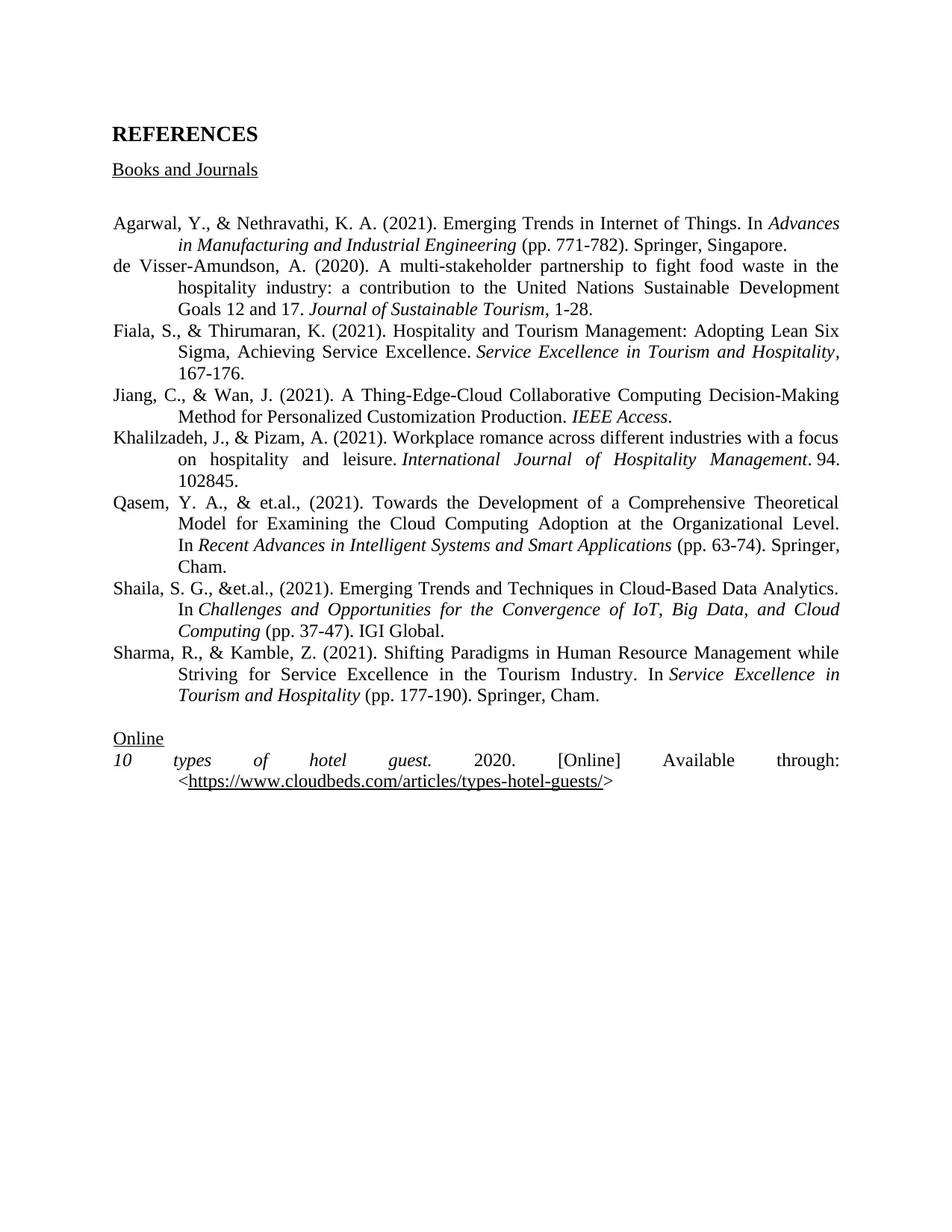
REFERENCES
Books and Journals
Agarwal, Y., & Nethravathi, K. A. (2021). Emerging Trends in Internet of Things. In Advances
in Manufacturing and Industrial Engineering (pp. 771-782). Springer, Singapore.
de Visser-Amundson, A. (2020). A multi-stakeholder partnership to fight food waste in the
hospitality industry: a contribution to the United Nations Sustainable Development
Goals 12 and 17. Journal of Sustainable Tourism, 1-28.
Fiala, S., & Thirumaran, K. (2021). Hospitality and Tourism Management: Adopting Lean Six
Sigma, Achieving Service Excellence. Service Excellence in Tourism and Hospitality,
167-176.
Jiang, C., & Wan, J. (2021). A Thing-Edge-Cloud Collaborative Computing Decision-Making
Method for Personalized Customization Production. IEEE Access.
Khalilzadeh, J., & Pizam, A. (2021). Workplace romance across different industries with a focus
on hospitality and leisure. International Journal of Hospitality Management. 94.
102845.
Qasem, Y. A., & et.al., (2021). Towards the Development of a Comprehensive Theoretical
Model for Examining the Cloud Computing Adoption at the Organizational Level.
In Recent Advances in Intelligent Systems and Smart Applications (pp. 63-74). Springer,
Cham.
Shaila, S. G., &et.al., (2021). Emerging Trends and Techniques in Cloud-Based Data Analytics.
In Challenges and Opportunities for the Convergence of IoT, Big Data, and Cloud
Computing (pp. 37-47). IGI Global.
Sharma, R., & Kamble, Z. (2021). Shifting Paradigms in Human Resource Management while
Striving for Service Excellence in the Tourism Industry. In Service Excellence in
Tourism and Hospitality (pp. 177-190). Springer, Cham.
Online
10 types of hotel guest. 2020. [Online] Available through:
<https://www.cloudbeds.com/articles/types-hotel-guests/>
Books and Journals
Agarwal, Y., & Nethravathi, K. A. (2021). Emerging Trends in Internet of Things. In Advances
in Manufacturing and Industrial Engineering (pp. 771-782). Springer, Singapore.
de Visser-Amundson, A. (2020). A multi-stakeholder partnership to fight food waste in the
hospitality industry: a contribution to the United Nations Sustainable Development
Goals 12 and 17. Journal of Sustainable Tourism, 1-28.
Fiala, S., & Thirumaran, K. (2021). Hospitality and Tourism Management: Adopting Lean Six
Sigma, Achieving Service Excellence. Service Excellence in Tourism and Hospitality,
167-176.
Jiang, C., & Wan, J. (2021). A Thing-Edge-Cloud Collaborative Computing Decision-Making
Method for Personalized Customization Production. IEEE Access.
Khalilzadeh, J., & Pizam, A. (2021). Workplace romance across different industries with a focus
on hospitality and leisure. International Journal of Hospitality Management. 94.
102845.
Qasem, Y. A., & et.al., (2021). Towards the Development of a Comprehensive Theoretical
Model for Examining the Cloud Computing Adoption at the Organizational Level.
In Recent Advances in Intelligent Systems and Smart Applications (pp. 63-74). Springer,
Cham.
Shaila, S. G., &et.al., (2021). Emerging Trends and Techniques in Cloud-Based Data Analytics.
In Challenges and Opportunities for the Convergence of IoT, Big Data, and Cloud
Computing (pp. 37-47). IGI Global.
Sharma, R., & Kamble, Z. (2021). Shifting Paradigms in Human Resource Management while
Striving for Service Excellence in the Tourism Industry. In Service Excellence in
Tourism and Hospitality (pp. 177-190). Springer, Cham.
Online
10 types of hotel guest. 2020. [Online] Available through:
<https://www.cloudbeds.com/articles/types-hotel-guests/>
1 out of 8
Related Documents
Your All-in-One AI-Powered Toolkit for Academic Success.
+13062052269
info@desklib.com
Available 24*7 on WhatsApp / Email
![[object Object]](/_next/static/media/star-bottom.7253800d.svg)
Unlock your academic potential
Copyright © 2020–2025 A2Z Services. All Rights Reserved. Developed and managed by ZUCOL.





